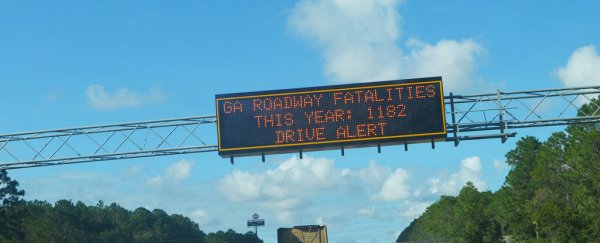Attention-grabbing signs that remind drivers of highway mortality can backfire in unexpected ways, according to a new study.
When cars in Texas zoom past crash statistics – like '1669 deaths this year on Texas roads' – researchers found drivers are 4.5 percent more likely to get in a crash in the next 10 kilometers (6.21 miles).
In Texas alone, that accident rate could account for 2,600 crashes a year and an additional 16 fatalities. If the same rate exists nationwide, it's possible road fatality reminders could be causing 17,000 car crashes in the US every year.
"Our study shows that salient, generic, in-your-face safety messages delivered to drivers crowd out more pressing safety concerns," the authors conclude.
While traffic signs about road safety might seem helpful or innocuous, there's a chance they are distracting drivers in a way that is more of a disaster than a deterrent.
That's a serious issue given that 28 states have adopted similar interventions.
Texas makes for a good case study because the state flashes fatality messages on the highway once a week each month. This allowed researchers to measure the impact of these messages on an hourly, daily, weekly, monthly, and yearly basis.
 (Jonathan Hall)
(Jonathan Hall)
Comparing car crashes from before the state's safety campaign started and after, researchers were surprised to find an immediate negative impact. It seemed the campaign was doing the exact opposite of what it was intended to do.
When fatality signs went up in campaign weeks, car crashes also went up. The result is comparable to raising the speed limit by 3 to 5 miles per hour (4.8 to 8 km/h) or reducing highway troopers by up to 14 percent.
Although initially surprised, the authors of the study have found a way to explain the results.
They propose that "sobering" messages like road fatalities are too "in-your-face". Instead of making a driver more alert, they simply make them more distracted.
By stealing some of a driver's limited attention and turning it into anxiety about death, road signs can cause drivers to overlook other essential considerations, like knowing where other cars are around them.
The 'distraction' hypothesis is also supported by the fact that an increase in car crashes from fatality signs was larger on Texas roads that were more complex, such as those with more traffic or more lanes and turn-offs.
Anxiety is also another key explanation. In the Texas study, as the actual number of car crash deaths flashed on a road increased, so, too, did the chances of a car crash happening in the following 10 kilometers.
This suggests that the more shocking the sign, the more likely someone will pay more attention to the risk than the road. When the annual fatality numbers restart in February, for instance, the rate of car crashes after the sign can drop by up to 11 percent from the previous month, effectively reducing crashes by a few percent.
Past psychological research has also shown that high anxiety levels can impact our performance on a task, driving us to overthink, which can override our reflexes. Yet, for some reason, that downside was a forgotten consideration when first adopting road safety campaigns.
While previous studies in the lab have shown that fatality messages can mess with a driver's cognitive load, research in the real world is limited. That said, vehicle simulators do indicate billboards, in general, are distracting to drivers.
"[I]t is important to measure an intervention's effect, even for simple interventions, because good intentions do not necessarily imply good outcomes," the authors of the Texas study warn.
Responding to the new findings in a related perspective, traffic control expert Gerald Ullman and psychologist Susan Chrysler note that the US Federal Highway Administration began discouraging the use of fatality numbers on the road in 2021.
The findings found in Texas support that decision.
"The crash data presented… clearly demonstrate a safety effect of showing fatality numbers on [dynamic message signs]," Ullman and Chrysler write.
"However, the mechanism for this safety effect is not clearly elucidated by the data presented in the paper. Additional analyses regarding crash types and documented causal factors in the crash reports might yield more insights."
The research is a good reminder that just because a public health policy seems helpful, it still needs to be taken for a test run.
The study was published in Science.
